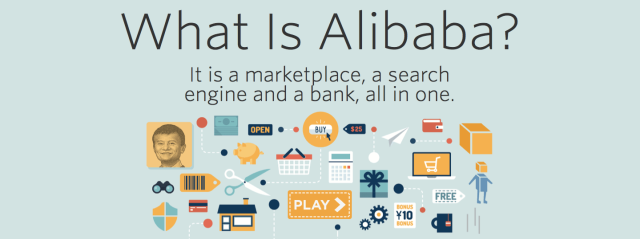Chinese ecommerce giant Alibaba’s business model has 2 main components – ECommerce and ad technology. Alibaba makes money through purchases happening on its ecommerce arm which is world’s largest and advertisement revenue using an ad technology which is among the best in world due to its sophisticated advertising technology and the future marketing potential. Alibaba as an eCommerce giant has been discussed in detail in my previous blog post Alibaba as eCommerce Giant. Alibaba’s foray into advertising is mainly aimed at increasing product sales for sellers at its market places and ecommerce sites, but its ad business has been also extended to advertisers wishing to push their products.
In advertisement value chain, role played by participants varies greatly depending on their position in the value chain. For example, Advertisers aim to get their products sold and focus on creating content that resonates well with their target audiences. I have discussed Advertising Value chain in detail my previous blog Digital Advertisement Value Chain. Well targeted content keeps audience engaged and leads to repeat visits and repeat purchase. Publishers like media companies and content creators sell their inventory to the advertisers and aim to fetch maximum money for their inventory. Data Management Platforms helps in providing insights about users and segment these users into audiences based on user’s online behaviour. These segmented audiences can then be sold to appropriate advertisers leading to higher CPMs for publishers and targeted sales for the advertisers.
Alibaba
Alibaba has large amount of users visiting to its various e-commerce platforms, market places and partner websites, leading to Alibaba getting access to vast trove of consumer and transactional data. Alibaba applies proprietary algorithms on these transactional data to evaluate quality of advertising inventory and based on these data predicts CTRs and conversion rates of marketing messages. This helps Alibaba segment advertising inventories leading better user targeting, increased marketing effectiveness, improved consumer targeting efficiency and enhanced ROI for advertisers.
For example Alibaba knows well in advance a user’s buying history and thus his taste, preferences and recent purchases. Based on this information and its targeting algorithms, Alibaba as a publisher is able to show perfectly targeted product advertisement to users. This in turn helps Alibaba increase product sales for merchants listed on its e commerce platform. It also helps Alibaba enter and mark its presence in the ever important advertisement business.
Key features of Alibaba’s online ad business are the following:
1. Data Management Platform
DMP helps in creating audience segments by using consumer’s online user behaviour (products people browse and buy) on Alibaba’s e-commerce platforms. Alibaba’s DMP data is further combined with advertiser’s audience data to deliver targeted advertisement to potential customers with similar attributes. This provides better targeting ability for advertisers on its ad exchange and its market place.
2. Taobao Ad Network and Exchange (TANX)
TANX is one of the earliest and one of the largest real time online advertising exchanges in China. TANX handles and automates third party buying and selling of billions of advertising impressions on a daily basis by on Alibaba market places and non-Alibaba sites through real-time bidding auctions. TANX is powered by its DMP wherein DMP helps participants on TANX leverage its transactional data to evaluate and select online advertising inventory using both behavioural data of users as provided by DMP and browsing behaviour and shopping history as provided by advertisers. Unlike Alimama, TANX allows for transparent pricing of advertising inventory leading to increased ROI for marketers. TANX is not limited to merchants only and any brand advertiser can buy ads on TANX. Participants on TANX include publishers, merchants, Demand Side Platforms and third-party data and technology companies
U.S. rivals: Google’s AdX, Yahoo Exchange (formerly Right Media), Facebook Exchange, Twitter’s Mopub
3. Taobao Affiliate Network
Taobao Affiliate Network is Alibaba’s network of third party sites like Weibo (China’s Twitter equivalent) wherein Taobao sellers run ads bought through Alimama. Sellers put marketing displays on our affiliates’ websites and mobile apps. Further, sellers pay a performance-based marketing fee primarily based on CPC or CPS basis with a significant portion of marketing fees getting shared with the participating affiliates.
Taobao marketplace is one of the most prominent Alibaba’s e commerce property with 100 million visitors a day.
Rivals – Google Display Network, Facebook Audience Network, AOL’s Advertising.com
4. Alimama
Online marketing service is primary source of revenue as said by Alibaba in its US SEC filing. Advertiser can choose content-based PPC advertising plan (like adsense) or purchase banner or text link based on CPI or cost per time. Alimama is an online marketing technology platform that provides online marketing services to sellers. These online marketing services include services such as:
- P4P marketing service: Sellers bid for keywords that appear in search or browser results on a CPC basis based on prices as determined by Alimama’s online auction system. This facilitates market based price discovery based on online bidding system. This is similar to bidding of key words on Google ad words.
- Display marketing: Seller bids for display positions on areas like landing pages, channel pages and delivery confirmation pages of Taobao Marketplace and Tmall or Alibaba’s third-party marketing affiliates at fixed prices or prices established by a real-time bidding system on a CPM basis. Alimama provides one stop solution to promote product brands Display Marketing helps to promote product brands on Alibaba Market Place (Taobao) and Alibaba’s network of third party sites namely Taobao Affiliate Network.
US Rivals – Amazon Advertising Platform, eBay Advertising, Google Shopping

One thought on “How Alibaba makes money and Alibaba’s business model”